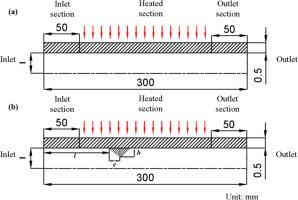Numerical studies of the enhanced thermal performance of regenerative cooling channel with triangular micro-rib
IF 3.9
3区 工程技术
Q3 ENERGY & FUELS
Chemical Engineering and Processing - Process Intensification
Pub Date : 2025-10-03
DOI:10.1016/j.cep.2025.110577
引用次数: 0
Abstract
Regenerative cooling technology plays a critical role in the thermal management of scramjets. However, its application in high Mach vehicles is limited by severe thermal stratification of n-decane, employed as a single-component surrogate for aviation kerosene, in the cooling channel. The incorporation of triangular micro-rib has received considerable attention for its potential to enhance fluid turbulence and heat transfer. To further elucidate these effects, this work employs computational fluid dynamics to simulate the cooling channel featuring a single triangular micro-rib with varying inclinations and placements. The simulations reveal that setting the triangular micro-rib close to the initial heating point yields markedly enhanced heat transfer compared to an end-positioned configuration. The optimal placement of micro-rib is determined to be 56 mm from channel inlet. This configuration raises the fluid outlet temperature by about 15 K over the smooth channel, achieving maximum total heat absorption. The triangular micro-rib with an aspect ratio e/h = 1/1 leads to an optimal trade-off, providing a heat sink of n-decane about 1.0 × 103 J/kg higher than that in rectangular rib channel, coupled with a 36.7 % reduction in stress compared to the e/h = 1/2 design.

三角形微肋蓄热冷却通道增强热性能的数值研究
蓄热式冷却技术在超燃冲压发动机的热管理中起着至关重要的作用。然而,作为航空煤油的单组分替代物,正癸烷在冷却通道中存在严重的热分层,限制了其在高马赫飞行器中的应用。三角形微肋的加入因其增强流体湍流和传热的潜力而受到相当大的关注。为了进一步阐明这些影响,本工作采用计算流体动力学来模拟具有不同倾角和位置的单个三角形微肋的冷却通道。模拟结果表明,与末端配置相比,将三角形微肋设置在初始加热点附近可以显著增强传热。确定微肋的最佳位置为距通道入口56 mm处。这种结构使流体出口温度在光滑通道上提高了约15k,实现了最大的总吸热。长径比为e/h = 1/1的三角形微肋带来了最佳的折衷,提供的正十二烷散热器比矩形肋通道高约1.0 × 103 J/kg,同时与e/h = 1/2设计相比,应力降低了36.7%。
本文章由计算机程序翻译,如有差异,请以英文原文为准。
求助全文
约1分钟内获得全文
求助全文
来源期刊
CiteScore
7.80
自引率
9.30%
发文量
408
审稿时长
49 days
期刊介绍:
Chemical Engineering and Processing: Process Intensification is intended for practicing researchers in industry and academia, working in the field of Process Engineering and related to the subject of Process Intensification.Articles published in the Journal demonstrate how novel discoveries, developments and theories in the field of Process Engineering and in particular Process Intensification may be used for analysis and design of innovative equipment and processing methods with substantially improved sustainability, efficiency and environmental performance.

 求助内容:
求助内容: 应助结果提醒方式:
应助结果提醒方式:


